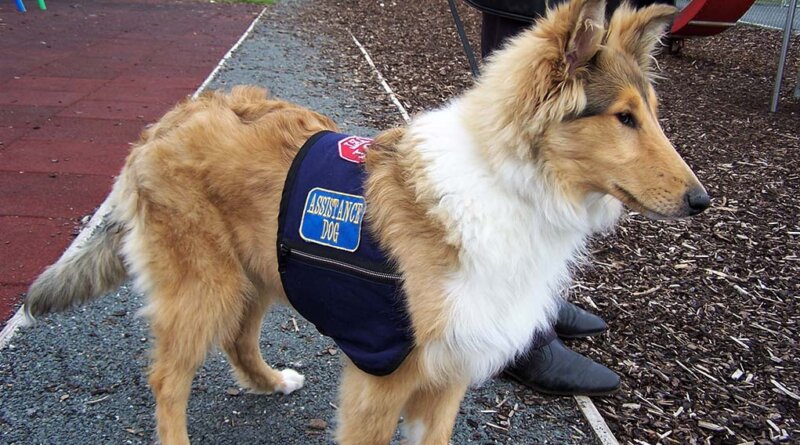How to Get a Service Dog for Anxiety or Depression (And the Costs Of It)
A number of recent studies have proven that assistance animals and therapy dogs provide great relief for people with different conditions, anxiety, and depression.
If you’re in this position, here’s everything you should know about getting a service dog for anxiety or depression, including what it entails, how an assistance dog can help with these mental health conditions, and the costs involved.
The Right Type of Service Dog
Is a dog that alleviates anxiety and depression in people considered a psychiatric service dog or an emotional support animal (ESA)? If you’re unsure about the difference between these two types of service dogs, read this explanation before continuing further.
When it comes to anxiety and depression, psychiatric service dogs and emotional support dogs can prove beneficial in relieving their handler/owner’s symptoms, but they do have a difference.
Whether you require an assistance dog and which category of an assistance dog is appropriate for you depends on the degree to which your anxiety or depression affects your day-to-day life.
Psychiatric service dogs and emotional support dogs are the two types that are “qualified” for people with these mental conditions. Below, I’ll explain how either of these types of assistance animals can help you and everything else you need to know about both.
The Psychiatric Service Dog

Here’s a simple example to illustrate this:
An individual suffering from extreme anxiety or depression may be unable to leave their home to do something as simple as picking up their medication which helps to mediate symptoms of their anxiety or depression.
In this instance, a psychiatric service dog can “assist [their] handler in creating a safe personal space in public, serving as a physical buffer to calm [their] handler and reduce feelings of emotional distress in crowded places.” (2) This allows their handler to pick up their medication.
When Does Depression or Anxiety Qualify as a “Disability”?
Depression and anxiety do not always qualify as a disability, which means that not everyone with these conditions can officially obtain a psychiatric service dog to mitigate their symptoms. It’s important to understand your situation and know whether you’ll qualify to get a service dog for anxiety or depression.
When is anxiety or depression considered disabling?
There’s an official definition for this. The ADA defines a disabling illness as an illness that physically or psychiatrically must limit one or more major life activities, such as walking, talking, seeing, hearing, learning, etc.
If the illnesses do not limit one or more life activities, you do not qualify for a service animal (3).
For example, the individual we referred to in the above example who cannot leave their home because of their anxiety would qualify as “disabled” because of their inability to engage in major life activity.
However, someone who experiences mild anxiety levels, such as having an increased level of worry about what other people are thinking about them while they are out picking up medications, is not considered to be disabled.
The former individual was unable to leave home (something which greatly impeded their daily life), the individual with mild anxiety may be uncomfortable leaving home to pick up medication.
However, they are still capable of doing so. It’s considered that their level of anxiety isn’t preventing them from living a full life.
That is not to say that a psychiatric service dog would not provide comfort to the individual with mild anxiety – they probably would; however, in such a case, a service dog is not considered to be a necessity.
How Does a Psychiatric Service Dog Aid in Relieving Symptoms of Anxiety and Depression?
Service dogs used for these mental conditions are becoming increasingly popular, and there are many great success stories.
There are several ways that a psychiatric service dog can aid in relieving the symptoms of anxiety or depression in people, including:
- Bringing medications or bringing water so your dog can take medication.
- Fetching helps during a dissociative episode or crisis.
- Laying over an anxious individual to provide physical comfort during anxiety attacks.
- Detecting anxiety attacks before they show themselves.
- Reminding severely depressed individuals to get out of bed or take medication.
- Bringing a phone to call for help or using an adapted phone device to call for help during a crisis.
How to Get a Psychiatric Service Dog for Anxiety or Depression
A psychiatric service dog can be obtained (1) through a service dog organization, or an individual (2) may train their own service dog themselves.
However, it’s important to note that training your own service dog can be tough, much more so than people initially imagine and far more complicated than “regular” dog training.
Let’s look at both of these options.
1. Obtaining a Service Dog Through a Service Dog Program

However, the training is not over yet because the dogs then undergo another set of rigorous specialized training to allow them to meet the needs of their specific handler (4).
Service dogs trained through service dog programs may be from a reputable breeder owned by that service dog program, from other third-party reputable breeders, or, in some rare instances, from shelters or rescues.
To qualify for a service dog from a psychiatric service dog training program, you will be subjected to certain “rules” or “requirements.” These rules or requirements vary depending on the program you apply with. A good example of some common requirements can be found on the Canine Partners for Life eligibility policy and include:
- Physical ability to control, manage and care for a large dog weighing 50 – 100 pounds and the ability to create an effective support system.
- Ability to communicate effectively and appropriately with the canine.
- Financial ability to provide for his/her canine partner’s daily care, routine, and emergency veterinary needs.
- A lifestyle that the increased independence would significantly enhance that a canine would provide.
- The willingness to seek assistance and advice from the graduate network.
- A realistic view of his/her disability and appraisal of his/her abilities.
- The motivation to achieve as much independence as is realistically possible.
- The ability to learn new information in a group setting, usually consisting of 12 – 16 students.
- An applicant medical information form.
- All graduates must attend “team training” classes to receive their service dog.
- All graduates must agree to attend graduate support classes as required.
The Cost of Getting a Psychiatric Service Dog Through a Professional Training Program
A psychiatric service dog’s cost will vary based on which service dog organization you contact. The average cost for a psychiatric service dog adopted for anxiety or depression runs between $20,000 to $30,000, which is obviously very expensive.
This high price reflects the time, effort, resources, and amount of work that goes into raising and specialty training an assistance dog that will be specialized for you specifically and is essential “custom-tailored” for your condition and lifestyle (5).
This may seem like a lot of money, but programs actually often spend much more than this to devote 600+ hours to training a dog, providing boarding for a dog, and providing vet care (6).
2. Training Your Own Service Dog
It is possible to save money by training your own service dog; however, this is a challenging task to undertake and requires dedication and many of the criteria required by the professional training programs noted above.
It would be best if you also kept in mind that training your own service dog will require a lot of discipline, time, and dedication.
Another benefit to training your own service dog (in addition to possibly saving money) is that there is no waiting list – many professional service dog organizations have lists of applicants for years into the future.
On the other hand, individuals with depression and/or anxiety may not be able to partake in hundreds of hours of training a service dog.
What Type of Dog Can Be a Psychiatric Service Dog?
Certain characteristics make a dog a good candidate for service dog work for people with depression or anxiety.
While many canines can possess these characteristics, a few breeds tend to display them more regularly, so they favor service dog work.
When assessing an animal’s suitability for service dog work, it’s important to consider the following questions:
- Are they capable of carrying out the tasks that are required of them to help their owner?
- Are they trainable?
- Do they have a high frustration threshold?
- Do they have a desire to please?
- Are they free from signs of personality flaws that may impact their ability to perform their job?
- Are they free from signs of genetic or physical illness that would impact their ability to perform their job?
- Are they people-centered?
- Are they distracted by excessive drive or energy?
- Are they otherwise easily distracted?
- Are they loud, reactive, or timid when faced with unfamiliar or overwhelming situations?
- Are they in their senior years? (senior dogs often experience the physical toll of age that can influence their ability to perform tasks. A reputable training program will not invest the money into training a dog that will only provide service for a short period.)
The key is to assess individual dogs rather than target specific breeds as being capable or incapable of providing service.
Although there should be some common sense in play, a chihuahua would not make a good mobility service dog.
The Cost of Training Your Own Psychiatric Service Dog
Training your own psychiatric service dog can still be expensive, depending on your approach and how much help you need. Generally, it can cost anywhere from a few thousand dollars to $20,000 (7).
This figure depends on the type of dog you select. Dogs that have already served as pet dogs are generally not well suited for service dog work, so you will more than likely want to select and adopt a new pup with the express purpose of service dog training in mind.
Just like service dog programs do, you will want to ensure that you choose a physically healthy and psychologically sound dog to begin working with. The best place for that is likely to be a legitimate breeder. From here, you will need to invest in training, beginning with the basics of obedience and working your way up to teaching specialized skills that are tailored to your needs.
Outfitting a Service Dog
There is a common misconception that a service dog must somehow be “marked” as a service dog either with a harness, a vest, or some other type of identification. This is untrue, and there is no official requirement to outfit your service animal: “The ADA does not require service animals to wear a vest, ID tag, or specific harness.” (9)
That said, you may still choose to pick up a service dog vest (better visibility, warning signs that you feel may be needed for others to see, etc.) or other supplies with a few features that allow you for better control of the dog or for the dog to assist you better.
Service Dog Licensing or Prescription Requirements
To have a psychiatric service dog, you do not have to have a doctor’s prescription. However, if you obtain your service dog through a service dog organization, they may ask questions about how a service dog would improve your life. This information will help them to match you up with the right canine for your special needs.
There is no requirement for a service dog to be licensed or registered with any special agency.
In fact; it’s discouraged to use “licensing services,” not only because they are a scam to make money off service dog owners, but because they are widely used by people posing with fake “service animals”.
And because of that, they make it much harder for legitimate service dog handlers by teaching business owners to expect service animals to be certified.
The U.S. Department of Justice even remarked quite recently that:
“There are individuals and organizations that sell service animal certification or registration documents online. These documents do not convey any rights under the ADA, and the Department of Justice does not recognize them as proof that the dog is a service animal.” (8)
Legal Protections of Psychiatric Service Dogs
Psychiatric service dogs are protected under the Americans with Disabilities Act, the Air Carrier Access Act (ACAA), and the Fair Housing Act. You can read more about the protections afforded to Service Dogs in our article here.
The Emotional Support Dog
Now let’s adopt emotional support dogs for anxiety or depression, which are slightly different from above mentioned psychiatric service dogs. Still, generally, many same things apply to this category of animals as well.

For individuals who do not qualify for a psychiatric service dog, emotional support dogs can still provide comfort in times of distress. An emotional support dog is a “lesser” choice because they cannot perform specific functions for their disabled owner with mental health conditions. Rather, they are dogs that “provide comfort just by being with a person.” (10)
Qualifying for an Emotional Support Dog
Unlike with psychiatric service dogs, to officially adopt an ESA and for the dog to be treated like an assistance animal, you will need to have a doctor’s prescription.
In the words of My Assistance Dog, Inc. “To have an emotional support animal, a person must have a confirmed diagnosis (usually of a mental illness) and be given a prescription for an ESA by an overseeing doctor who believes the pet will be of benefit to the patient’s mental health.” (11)
Getting an Emotional Support Dog for Anxiety or Depression
If you are specifically looking to bring home a dog that can serve as an emotional support dog (and do not require the specific assistance that psychiatric service dogs can provide), some rescue organizations and breeders do make a note of dogs within their programs which would make good ESA’s.
Often, a potential ESA is marked on the dog’s adoption profile or profile on their breeder’s notes, but if it isn’t, try contacting the rescue or breeder directly and ask if they have or can help you to find a dog that suits your needs.
What Makes a Good Emotional Support Animal?
Obviously, since the purpose of adopting an emotional support animal for anxiety or depression is primarily to provide comfort, then the animal in question must be good at providing said comfort to its handler.
However, there are also other factors to consider when deciding whether a specific canine makes a good emotional support animal, including:
- The size of your emotional support animal may be a concern if you are limited in your physical activity, if you live in a tiny home, or if you plan to take your ESA on flights with you.
- A good temperament is a necessity – both towards you and other people and animals.
- Overall health should be a concern as it may limit your dog’s ability to provide emotional support.
How Can an Emotional Support Dog Help with Depression or Anxiety?
While psychiatric service dogs are specifically trained to assist owners with mental health conditions in many ways, an emotional support animal provides comfort to their owner by simply “being” with them, which can often be all a person with depression or anxiety really needs.
Some examples of how service dogs do that include:
- Providing a “listening ear” for anxious individuals.
- Providing physical closeness for depressed individuals.
- Providing a calming tactile sensation to detract from anxiety.
- Providing a reason to get out of bed, i.e., walking the dog, feeding the dog, etc., for severely depressed individuals.
Emotional Support Dog Licensing or Prescription Requirements
Same as with psychiatric service dogs, there is no official licensing of emotional support dogs by individual organizations. However, as mentioned above, a person requiring an emotional support dog and wanting to use ESA’s services legally should have a “prescription from an overseeing doctor who believes the pet will be of benefit to the patient’s mental health.” (12)
Legal Protections of Emotional Support Dogs
Another difference from psychiatric service dogs is that emotional support dogs are not provided for under the Americans with Disabilities Act. They are, however, provided for under the Air Carrier Access Act (ACAA) and the Fair Housing Act. You can read more about the protections afforded to Emotional Support Dogs in our article here.
READ NEXT: How to Make Your Dog an Emotional Support Dog
Pin and share with other dog owners:







After study a few of the blog posts in your web site now, and I truly like your way of blogging. I bookmarked it to my bookmark website list and will probably be checking again soon. Pls take a look at my website online as nicely and let me know what you think.
I wish to show some thanks to this writer for bailing me out of this challenge. After surfing around throughout the internet and seeing ways which are not beneficial, I believed my entire life was done. Living minus the approaches to the difficulties you have resolved as a result of the website is a crucial case, and the ones that could have in a negative way damaged my career if I had not discovered the blog. Your main know-how and kindness in controlling every part was crucial. I’m not sure what I would’ve done if I hadn’t come across such a thing like this. I can at this point look forward to my future. Thanks so much for this expert and sensible guide. I will not be reluctant to recommend your blog to anybody who will need recommendations on this topic.
Wow, fantastic blog layout! How long have you been blogging for? you make running a blog look easy. The full look of your website is fantastic, as well as the content material!
My developer is trying to convince me to move to .net from PHP. I have always disliked the idea because of the costs. But he’s tryiong none the less. I’ve been using Movable-type on several websites for about a year and am anxious about switching to another platform. I have heard very good things about blogengine.net. Is there a way I can transfer all my wordpress posts into it? Any help would be really appreciated!
I?¦ve recently started a site, the information you offer on this web site has helped me tremendously. Thanks for all of your time & work.
Respect to author, some wonderful selective information.
An interesting discussion is worth comment. I think that you should write more on this topic, it might not be a taboo subject but generally people are not enough to speak on such topics. To the next. Cheers
What Is Sugar Defender? Sugar Defender is a natural blood sugar support formula created by Tom Green. It is based on scientific breakthroughs and clinical studies.
Good write-up, I am regular visitor of one?¦s blog, maintain up the nice operate, and It is going to be a regular visitor for a lengthy time.